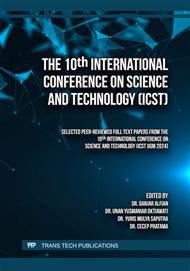[1]
J. Liang, W. -H. Liao and Y. -C. Wu, "Toward Automatic Recognition of Cursive Chinese Calligraphy: An Open Dataset For Cursive Chinese Calligraphy Text," 2020 14th International Conference on Ubiquitous Information Management and Communication (IMCOM), Taichung, Taiwan, 2020, pp.1-5.
DOI: 10.1109/imcom48794.2020.9001777
Google Scholar
[2]
P. Isola, J. -Y. Zhu, T. Zhou and A. A. Efros, "Image-to-Image Translation with Conditional Adversarial Networks," 2017 IEEE Conference on Computer Vision and Pattern Recognition (CVPR), Honolulu, HI, USA, 2017, pp.5967-5976.
DOI: 10.1109/cvpr.2017.632
Google Scholar
[3]
I. Goodfellow, J. Pouget-Abadie, M. Mirza, B. Xu, D. Warde-Farley, S. Ozair, A. Courville, Y. Bengio, Generative adversarial nets, Adv. Neural Inf. Process. Syst. 27 (2014).
DOI: 10.1145/3422622
Google Scholar
[4]
K. Nikolaidou, G. Retsinas, V. Christlein, M. Seuret, G. Sfikas, E.B. Smith, H. Mokayed, M. Liwicki, Wordstylist: Styled verbatim handwritten text generation with latent diffusion models, International Conference on Document Analysis and Recognition, Springer, 2023, p.384–401.
DOI: 10.1007/978-3-031-41679-8_22
Google Scholar
[5]
K.S. Chung, Wade–Giles romanization system, The Routledge Encyclopedia of the Chinese Language, Routledge, 2016, p.794–814.
Google Scholar
[6]
M. Brooks, Quantum computers: what are they good for? (Online; accessed 24-May-2023), Available: https://www.nature.com/articles/d41586-023-01692-9
Google Scholar
[7]
CompTIA's AI Advisory Council, 10 things you should know about quantum computing and AI, (Online; accessed 20-October-2022), Available: https://connect.comptia.org/blog/10-things-you-should-know-about-quantum-computing-and-ai
DOI: 10.1302/3114-221590
Google Scholar
[8]
M. Kölle, G. Stenzel, J. Stein, S. Zielinski, B. Ommer, C. Linnhoff-Popien, Quantum denoising diffusion models, arXiv preprint arXiv:2401.07049, 2024.
DOI: 10.1109/qsw62656.2024.00023
Google Scholar
[9]
J. Ho, A. Jain, P. Abbeel, Denoising diffusion probabilistic models, Adv. Neural Inf. Process. Syst. 33 (2020) 6840–6851.
Google Scholar
[10]
R. Rombach, A. Blattmann, D. Lorenz, P. Esser and B. Ommer, "High-Resolution Image Synthesis with Latent Diffusion Models," 2022 IEEE/CVF Conference on Computer Vision and Pattern Recognition (CVPR), New Orleans, LA, USA, 2022, pp.10674-10685.
DOI: 10.1109/cvpr52688.2022.01042
Google Scholar
[11]
A. Barenco, C.H. Bennett, R. Cleve, D.P. DiVincenzo, N. Margolus, P. Shor, T. Sleator, J.A. Smolin, H. Weinfurter, Elementary gates for quantum computation, Phys. Rev. A 52 (5) (1995) 3457.
DOI: 10.1103/physreva.52.3457
Google Scholar
[12]
J. Biamonte, P. Wittek, N. Pancotti, et al. Quantum machine learning. Nature 549, 195–202 (2017).
DOI: 10.1038/nature23474
Google Scholar
[13]
P.-L. Dallaire-Demers, N. Killoran, Quantum generative adversarial networks, Phys. Rev. A 98 (1) (2018) 012324.
DOI: 10.1103/physreva.98.012324
Google Scholar
[14]
C. Chen, Q. Zhao, Quantum generative diffusion model, arXiv preprint arXiv:2401.07039, 2024.
Google Scholar


